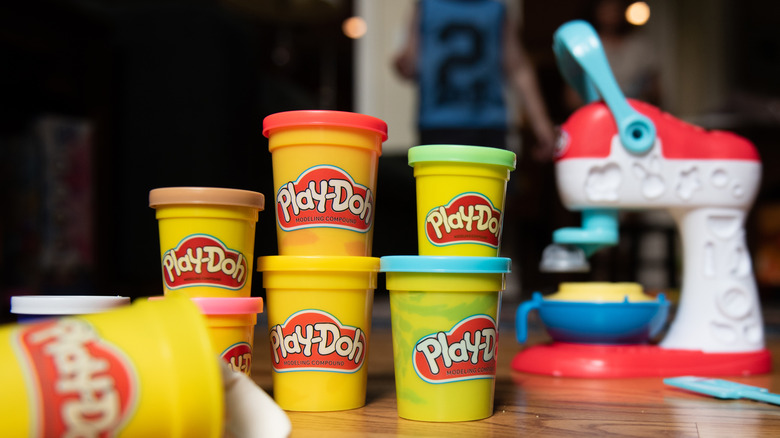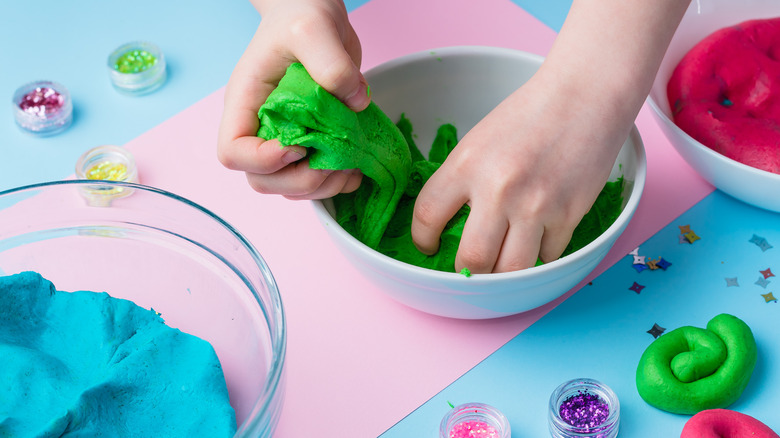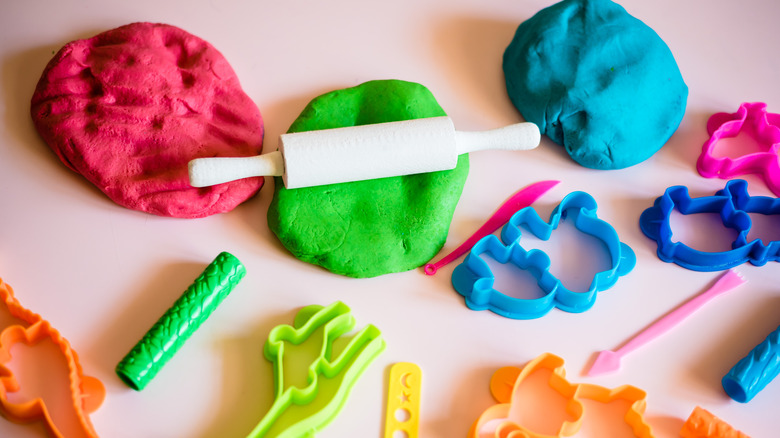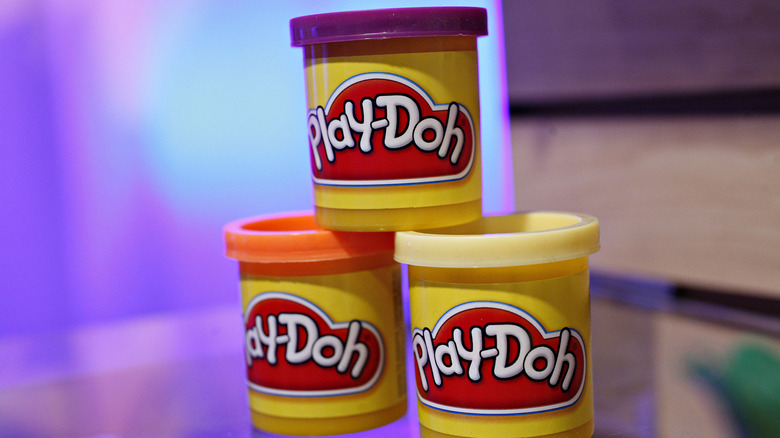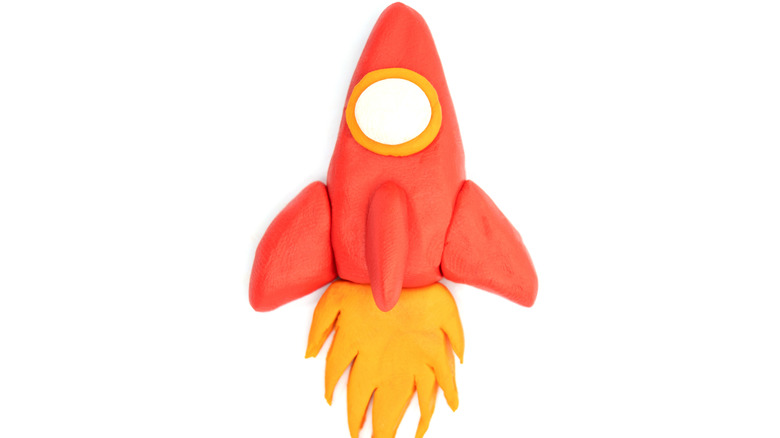What Happened To Play-Doh?
There are few toys that are as instantly evocative of childhood as Play-Doh — the iconic yellow container with the big white font that looks as if it's made from the contents inside; the very specific, salty-plastic Play-Doh smell; and of course, the cool, pliable dough that immediately invites shaping, rolling, and mashing. What's truly amazing about the colorful clay seemingly tailor-made for kids' creative play is the fact that it was invented for an entirely different, decidedly utilitarian purpose.
Per New Jersey Advance Media, what became Play-Doh started out as an invention by Joe McVicker and Bill Rhodenbaugh of Kutol Products, a soap company in Cincinnati, Ohio. In the 1930s, they developed and sold a non-sticky, pliable putty that could be used to remove coal residue from wallpaper and was sold under the name of Kutol, pronounced "cut-all." It was an efficient product that sold well, but it was made obsolete by the 1950s with the invention of vinyl wallpaper, which was easily washable with soap and water.
Play-Doh started out as a wallpaper cleaner
Kutol was no longer needed for its original purpose, but it was about to enter its second phase thanks to a resourceful New Jersey nursery school teacher. As reported by New Jersey Advance Media, Kay Zufall had read in a magazine that Kutol could be used to create art projects. By that time, Kutol was no longer being produced and marketed, but she found one old can left in stock at a local hardware store in Dover, New Jersey. In a wild coincidence, Joe McVicker — one of the original inventors of Kutol — was Zufall's brother in law, and he reassured her that it was safe for children to handle the putty, as it was made of non-toxic ingredients: flour, salt, water, boric acid, and mineral oil.
Kutol was a hit with the kids in Zufall's class, and she was able to convince McVicker that he should start manufacturing it again, this time marketing it as a children's toy. McVicker and his partner, Bill Rhodenbaugh, set out to rebrand their product as Rainbow Modeling Compound, but Zufall and her husband convinced them to instead use the shorter, more memorable name they'd come up with: Play-Doh.
Play-Doh started out in Cincinnati before going nationwide
According to the Strong National Museum of Play, Joe McVicker established Rainbow Crafts Company, Inc. in 1956 as a subsidiary of Kutol Products and began marketing the rebranded Play-Doh to local schools near the manufacturing plant in Cincinnati, Ohio. Its first iteration was the standard, off-white color of the original Kutol wallpaper cleaner, but by 1957, Play-Doh was available in the three primary colors: red, yellow, and blue.
McVicker wanted Play-Doh to reach a wider audience and be sold in stores for home use as well as distributed to schools but lacked the funds for an advertising campaign that would get the word out. Per Tim Walsh's 2005 book "Timeless Toys: Classic Toys and the Playmakers Who Created Them," McVicker took Play-Doh to a convention for school supply companies, where the Washington, D.C. department store Woodward & Lathrop became Rainbow Crafts' first retail client. Accounts with Macy's in New York and Marshall Field's in Chicago followed, but Play-Doh didn't get nationwide exposure until McVickers came up with a clever partnership that assured Play-Doh would be seen in homes across the United States.
Play-Doh had a fan in Captain Kangaroo
In an interview in "Timeless Toys: Classic Toys and the Playmakers Who Created Them," Rainbow Crafts co-founder Bill Rhodenbaugh said his partner Joe McVicker was a charismatic and gutsy salesperson who talked his way into a meeting with television host Bob Keeshan, better known by the name of his famous character, Captain Kangaroo. Per Rhodenbaugh, "Keeshan liked Play-Doh and wanted it on his show. But Joe told him we didn't have any money for advertising. So Joe offered him 2% of our sales if he would feature it on the show once a week." Play-Doh was such a hit with Keeshan that he started featuring it three times a week, which led to partnerships with more children's television programs, including "Ding Dong School" and "Romper Room."
Being featured on television led to lots of demand, and soon Rainbow Crafts needed 16 months to fill the massive number of backorders for Play-Doh. Furthermore, it was extremely profitable. "We would sell wallpaper cleaner for 34 cents a can, but Play-Doh — same stuff, same can — we'd sell for $1.50," Rhodenbaugh said (per Timeless Toys). Between 1954 and 1958, Rainbow Crafts' Play-Doh sales went from $100,000 to almost $3 million.
The Play-Doh Fun Factory was developed by engineers
In 1960, as reported by the Strong National Museum of Play, Rainbow Crafts added Play-Doh accessories to their product line and hired engineers to develop what became the Play-Doh Fun Factory. The lever came with different plates that allowed children to create multiple shapes and designs with Play-Doh. By 1964, the company was shipping over a million cans per year, and that same year they began exporting to England, France, and Italy (via "Timeless Toys: Classic Toys and the Playmakers Who Created Them").
One year later, General Mills bought Rainbow Crafts and placed Play-Doh under the brand name Kenner. By 1972, Kenner sold the 500-millionth can of Play-Doh. In 1983, four more colors were added to the Play-Doh palette, and in 1991, Hasbro acquired Play-Doh and continues to manufacture it to this day. The Strong Museum inducted Play-Doh into its National Toy Hall of Fame in 1998 and notes that Hasbro has produced various novelty versions of the classic product, including those that glow in the dark, feature glitter, and smell like shaving cream.
Play-Doh mascots have come and gone
Per the Strong Museum's National Toy Hall of Fame, children have played with a total of 700 million pounds of Play-Doh since it came onto the market. The mascot has also changed over the years; as recounted by "Timeless Toys: Classic Toys and the Playmakers Who Created Them," the first was the Play-Doh Pixie, who appeared in the mid-1950s and looked like a combination of Elmer Fudd and Peter Pan. The introduction of Play-Doh Pete — a young blond-haired boy wearing an artist's smock and beret – came in 1960, and he kept the first outfit for decades. By the 2000s, Pete was given a spiky hairdo and backward baseball cap until he was retired in 2003. In 2012, Hasbro introduced the Doh-Dohs, the creation of artist Steven Block, who describes them as "Part Three Stooges, part 'South Park,' and all things awesome."
Hasbro's own Play-Doh website encourages users to "shape your imagination" and includes a wide range of products and accessories, including Slime, Foam, and Cloud formulas.
